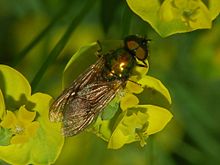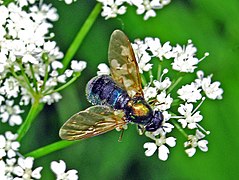Chloromyia formosa
| Chloromyia formosa | |
|---|---|

| |
| Chloromyia formosa. Male | |

| |
| Female | |
| Scientific classification | |
| Domain: | Eukaryota |
| Kingdom: | Animalia |
| Phylum: | Arthropoda |
| Class: | Insecta |
| Order: | Diptera |
| Family: | Stratiomyidae |
| Subfamily: | Sarginae |
| Genus: | Chloromyia |
| Species: | C. formosa
|
| Binomial name | |
| Chloromyia formosa | |
| Synonyms | |
Chloromyia formosa is a species of
Distribution
This species is present in most of Europe (Austria, Belgium, Bulgaria, Czech Republic, Denmark, Finland, France, Germany, Greece, Ireland, Italy, Luxembourg, Netherlands, Norway, Poland, Russia, Spain, Sweden, Switzerland, United Kingdom), in the Near East, in the Nearctic realm, and in North Africa.[10]
Habitat
These flies mainly inhabit wooded areas, hedge rows, moist forests, wet meadows, parks and gardens.[11]
Description
Chloromyia formosa can reach a length of 7.3–9 millimetres (0.29–0.35 in) and a wing length of 6–7 millimetres (0.24–0.28 in).[11] Their body is elongated, the thorax is metallic green, the head is hemispherical without hair, while the eyes are quite hairy. Antennae are short, the first antennal segment is longer than the second. The legs are black, only the knees are yellow. The abdomen is flattened and broad.
An evident dimorphism exists between the males and the females of this species. In females the abdomen is blue-green with a purple sheen (depending on the light), while in males it shows a copper-green sheen. The female’s eyes are separated from each other. The wings are yellowish-brown.
-
Male, with copper-green abdomen
-
Female, with blue-green abdomen
Biology
Adults can mostly be encountered from April through August, feeding on nectar of flowers (mainly of Apiaceae species) and on pollen of Filipendula ulmaria (Rosaceae).[11] Between April and August these insects mate several times. The larvae develop in humus-rich soil, feeding on dead leaves and other decaying vegetal substances.[11] After reaching the final stage larvae overwinter.
Bibliography
- Gibson, R. H., Nelson, I. L., Hopkins G. W., Hamlett, B. J., Memmott J. (2006). Pollinator webs, plant communities and the conservation of rare plants: arable weeds as a case study. Journal of Applied Ecology 43: 246—257
- Mason, F., Rozkošný, R., Hauser, M. (2009). A review of the soldier flies (Diptera: Stratiomyidae) of Sardinia. Zootaxa 2318: 507–530
- Nartshuk, E. P. (2009). The character of soldier fly distribution (Diptera, Stratiomyidae) in Eastern Europe. Entomological review 89(1): 46-55. DOI:10.1134/S0013873809010072
- Rozkošný, R. 1998. Chapter 24. Family Stratiomyidae. Manual Palaearct. Dipt. 2: 387-411.
References
- ^ a b Scopoli, I.A. (1763). Entomologia carniolica exhibens insecta carnioliae indigena et distributa in ordines, genera, species, varietates. Methodo Linnæana. Vindobonae [= Vienna]: Trattner. pp. [30] + 420 pp. Retrieved 23 June 2021.
- ^ De Geer, C. (1776). Memoires pour servir a l'histoire des insectes. Stockholm: P. Hesselberg. pp. viii + 523 pp., 30 pls.
- ^ Fabricius, J.C. (1787). Mantissa insectorum. Vol. 2. Hafniae [=Copenhagen]: C. G. Proft. pp. [2] + 382 pp.
- ^ Meigen, J.W. (1804). Klassifikazion und Beschreibung der europäische n zweiflugeligen Insekten (Diptera Linn.). Erster Band. Abt. I. Braunschweig [= Brunswick]: Reichard. pp. xxviii + pp. 1–152, Abt. II. vi + pp. 153–314.
- ^ Walckenaer, C.A. (1802). Faune Parisienne. Insectes ou histoire abregee des insectes des environs de Paris. Paris: Dentu. pp. Vol. 1, viii+ cxxx + 303 pp. Vol. 2, xxii + 438 + [ii] pp. Retrieved 23 May 2021.
- ^ Loew, Hermann (1840). "Bemerkungen uber die in der Posener Gegend einheimischen Arten mehrerer Zweiflugler=Gattungen". [Zu der] offentlichen Prufung der Schuler des Koniglichen Friedrich-Wilhelms-Gymnasiums zu Posen. 1840: 40 pp., 1 pl.
- ISBN 9781899935079.
- ^ Woodley, N.E. (2001). "A World Catalog of the Stratiomyidae (Diptera)" (PDF). Myia. 11: 1–462. Retrieved 7 December 2022.
- ISBN 9789051070682.
- ^ Fauna europaea
- ^ a b c d J.K. Lindsey Commanster Archived 2010-01-01 at the Wayback Machine


